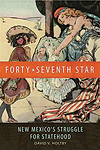 Forty-Seventh Star: New Mexico’s Struggle for Statehood, by David V. Holtby, University of Oklahoma Press,?Norman, 2012, $29.95
Forty-Seventh Star: New Mexico’s Struggle for Statehood, by David V. Holtby, University of Oklahoma Press,?Norman, 2012, $29.95
How in the world did it take New Mexico 64 years to become a state in the Union? The ratification of the Treaty of Guadalupe Hidalgo in February 1848 made New Mexico part of the United States. Right away its legislature petitioned the U.S. Congress for statehood. No dice. Senator Daniel Webster bad-mouthed the residents in March 1848, saying, “It is farcical to talk of such people making a constitution for themselves.” Webster’s verbal attack on New Mexico, writes Holtby, “besmirched its reputation for more than 60 years.” At least New Mexico officially became a territory on September 9, 1850, thanks to the Compromise of 1850 (Utah, too, achieved territorial status), which also empowered New Mexico citizens to decide whether to permit slavery. New Mexico rejected slavery, but officials did consider allowing New Mexico to enter as a slave state to appease the South. Secession arrived too quickly to make that happen. Then came war. The next big push for statehood came in the mid-1870s. Colorado got it; New Mexico didn’t.
Holtby, former editor in chief of University of New Mexico Press, writes, “Statehood became entangled in Republican and Democratic politics…and intraparty fights between proponents and opponents.” Some members of Congress questioned the progressiveness of Neuvomexicanos. But the blame for the delay to statehood does not rest entirely on national politics. Some of the leading supporters of statehood in New Mexico were scoundrels, says the author. “Their miscues, hoaxes and frauds invariably surfaced at the most inopportune times, giving opponents ample evidence that the territory was unfit to enter the Union,” he writes in his preface. It didn’t help that a small number of powerful, greedy and corrupt men—the so-called Santa Fe Ring—ran the show.
Progress seemed inevitable in the territory once the railroad arrived in February 1879. Promotion of statehood by fostering modernization and economic growth became a big deal in the 1890s. Albert J. Beveridge, a Republican senator from Indiana, delayed statehood for partisan political reasons as the chair of the Senate Committee on Territories between 1901 and 1911. Complicating matters were the proponents of the plan to unite Arizona and New Mexico as one state. It was thought that Theodore Roosevelt, who sometimes promoted New Mexico, would bring about statehood, but he didn’t make it happen. His successor as president, William Taft, was the one who secured statehood, though he receives little credit for it. “Taft,” writes Holtby, “succeeded because he exerted the very strength of conviction that Roosevelt talked about so much but never brought to bear on New Mexico statehood.” When Taft signed the proclamation, the celebratory photographs excluded Roosevelt and Beveridge.
For the record, New Mexico officially became the 47th state on January 6, 1912, and Arizona became No. 48 on February 14. Both states celebrated their 100th anniversaries in grand style in 2012. Holtby’s compelling tale is worth celebrating as well for doing such a good job of explaining how corruption, racism and partisan politics were key factors that made the road to statehood as bumpy as the road to Chaco Canyon.
One thing is certain. Neither the territory of New Mexico nor the territory of Arizona was going to revert to Mexico. But that unusual notion still makes for entertaining reading in Statehood of Affairs (iUniverse, Bloomington, Ind.), a 2011 book of historical fiction by Daniel R. Cillis. In this imaginary 1911 scenario another war between Mexico and the United States threatens due to a missing document, called the Revert Document, that could allow Old Mexico to legally recover the two lost territories. It might help, though, to know the real history first.
—Editor




